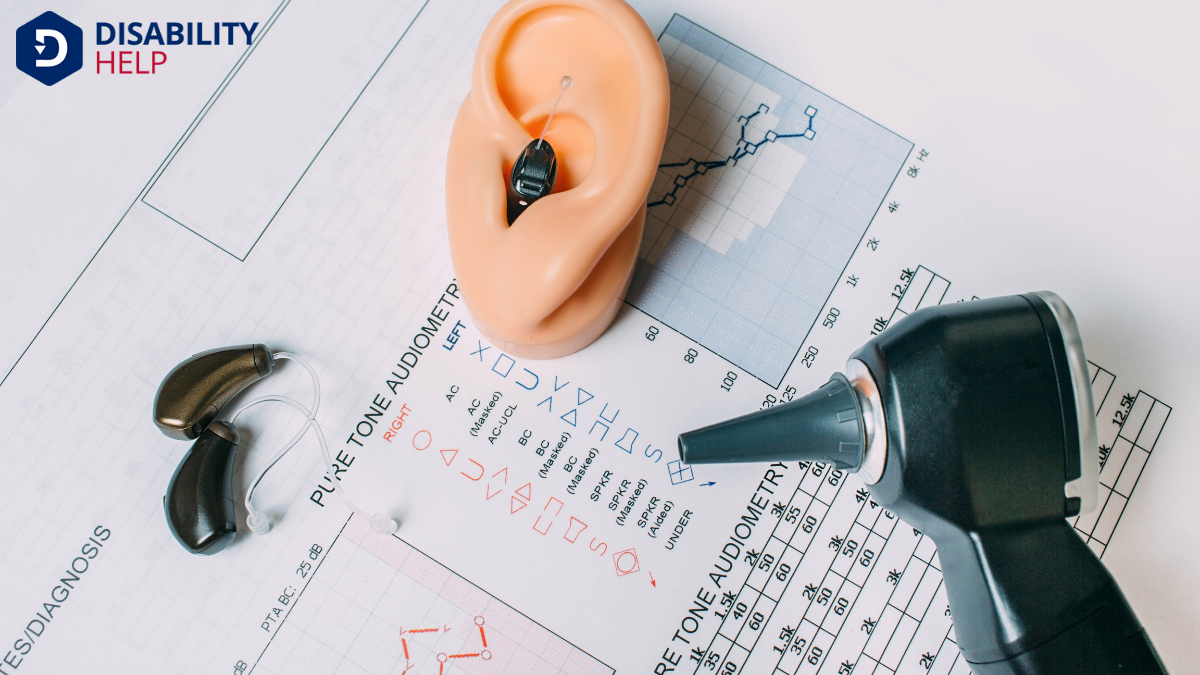Let's explore the fascinating world of technology that enhances hearing. With advanced hearing aids, cochlear implants, and bone-anchored systems, we're seeing significant strides in improving sound clarity for those with hearing impairments. Bluetooth and AI integration offer seamless connectivity and real-time adjustments, while smartphone apps provide features like noise reduction and transcription. These innovations are not just about better hearing; they're about empowermentThe process of gaining control, authority, and power over one’s life, often used in the context of... and engagement. Curious about how these work together?
Key Takeaways
- Advanced hearing aids use digital technology to reduce noise and enhance desired sounds for clearer conversations.
- Cochlear implants bypass damaged ear parts to directly stimulate the auditory nerve for improved sound perception.
- Bone anchored hearing systems transmit sound vibrations directly to the cochlea through the skull.
- AI in hearing aids offers real-time adjustments for seamless mode switching and noise reduction.
- Smartphone apps provide sound enhancement and transcription features for improved communication.
Advanced Hearing Aids
When we consider the latest advancements in hearing technology, advanced hearing aids stand out as a game-changer. They’re not just about amplifying sound; they’re smart devices designed to enhance our overall hearing experience.
These aids use digital technology to adjust to different environments, reducing background noise and focusing on the sounds we want to hear. They can connect to smartphones, allowing us to stream calls and music directly.
Additionally, they’re customizable, fitting our unique hearing needs. By continuously learning and adapting, they offer us a tailored experience, making conversations clearer and more enjoyable.
With these advancements, we gain more control over our hearing, allowing us to engage fully in life’s moments, without feeling left out.
Cochlear Implants
Let's explore how cochlear implants transform the way we perceive sound by discussing their functionality and benefits.
We'll also take a look at the surgical procedure involved and the latest advancements that make these devices even more effective.
Functionality and Benefits
Although hearing aids have long been the go-to solution for hearing lossPartial or total inability to hear sounds in one or both ears., cochlear implants offer a transformative alternative for those with severe to profound hearing impairments.
Unlike hearing aids, which amplify sound, cochlear implants bypass damaged parts of the ear and directly stimulate the auditory nerve.
This process allows us to perceive sound in a way we mightn't otherwise experience.
Surgical Procedure Overview
Understanding cochlear implants' role in hearing restoration requires a look at the surgical procedure that enables such advancements.
When we explore this process, we’ll see it involves placing a small electronic device under the skin behind the ear. The procedure starts with an incision where the implant will reside. Surgeons then carefully insert electrodes into the cochlea, which allows the device to bypass damaged portions of the ear and directly stimulate the auditory nerve. This step is essential for transmitting sound signals to the brain.
We must remember that while the surgery is generally safe, it requires skilled surgical expertise.
Post-surgery, patients often undergo a rehabilitationThe process of helping individuals with disabilities achieve and maintain their optimal physical, se... process to adaptA grassroots disability rights organization in the U.S. that focuses on promoting community-based se... to the new sounds, ensuring the best outcome from their cochlear implants.
Advancements and Innovations
Cochlear implants have come a long way, and we're witnessing an era of remarkable advancements and innovations. These devices are no longer bulky or cumbersome; they've become smarter and more effective, offering improved sound quality and better user experiences.
Modern implants can be fine-tuned to suit individual needs, allowing us to hear more naturally and comfortably. Wireless technology now enables seamless connections with smartphones and other devices, making communication more accessible than ever.
Additionally, advancements in speech processing algorithms help filter out background noise, which greatly enhances our ability to understand conversations in noisy environments.
These innovations don't just improve hearing; they enrich lives by bridging communication gaps. We're truly living in a time where technology transforms hearing possibilities, offering hope and connection.
Bone Anchored Hearing Systems

Let's explore how bone anchored hearing systems work and the benefits they offer.
These systems bypass the outer and middle ear by transmitting sound vibrations directly to the cochlea through the skull.
This approach not only enhances sound clarity for those with conductive hearing loss but also provides a more comfortable and less invasive solution compared to traditional hearing aids.
How Bone Anchoring Works
Although traditional hearing aids amplify sound through the ear canal, bone anchored hearing systems take a different approach by transmitting sound vibrations directly to the inner ear via the skull. This technology bypasses the outer and middle ear, making it an excellent option for individuals with conductive hearing loss or single-sided deafnessSignificant hearing loss that affects the ability to communicate or perceive sounds..
We begin by implanting a small titanium fixture into the skull behind the ear. Over time, the bone integrates with this fixture, creating a stable anchor.
A sound processor is then attached externally, capturing sound waves and converting them into vibrations. These vibrations travel through the implant and skull, reaching the inner ear directly.
In this way, we enable sound perception without relying on the traditional auditory pathway, offering an innovative solution for hearing challenges.
Benefits of Bone Systems
One of the major benefits of bone anchored hearing systems is their ability to provide clear sound quality for individuals who struggle with traditional hearing aids. These systems work by directly stimulating the inner ear through bone conduction, bypassing any damaged parts of the ear. This can be especially helpful for those with conductive hearing loss or single-sided deafness.
We find that another advantage is their comfort. Since these devices don't sit in the ear canal, they reduce irritation and infections associated with regular hearing aids.
Additionally, bone anchored systems offer a more natural sound perception, as they transmit sound vibrations directly to the cochlea. This technology empowers us to engage more fully in conversations, enhancing our quality of life and social interactions.
Assistive Listening Devices
While many of us may take hearing for granted, Assistive Listening Devices (ALDs) play an essential role in bridging the gap for those with hearing impairments.
These devices amplify sound directly to the user's ear, making it easier to engage in conversations and enjoy audio experiences. ALDs are especially useful in environments where background noise or distance would otherwise hinder hearing.
Key features of ALDs include:
- Personalized Sound Amplification: ALDs can be tailored to specific hearing needs, enhancing the user's ability to hear clearly.
- Compatibility with Hearing Aids: Many ALDs integrate seamlessly with hearing aids, providing an additional layer of sound enhancement.
- Portable and User-Friendly: Designed with ease of use in mind, ALDs are typically compact and easy to operate, offering convenience on the go.
Bluetooth and Wireless Connectivity
As we explore the advancements in assistive listening devices, Bluetooth and wireless connectivity stand out as game-changers in enhancing user experience. They allow us to seamlessly link our hearing aids with smartphones, tablets, and TVs, transforming how we interact with sound.
We can stream music, take calls, and enjoy media directly through our hearing aids, offering a more integrated and hands-free experience. Wireless connectivity reduces background noise, letting us focus on what truly matters.
It enables us to connect to multiple devices simultaneously, providing flexibility and convenience. Additionally, remote control apps allow us to adjust settings discreetly, ensuring personalized comfort.
These technologies make our lives easier by bridging the gap between our hearing aids and the digital world.
AI and Sound Optimization

Artificial Intelligence (AI) is revolutionizing how we optimize sound in our hearing aids. It allows us to experience clearer and more personalized audio by automatically adjusting to our environment.
With AI, our hearing aids can learn our listening preferences and adapt in real-time, enhancing our overall auditory experience. This technology guarantees that we’re not just hearing but truly understanding the sounds around us.
Here are some ways AI enhances sound optimization:
- Real-time adjustments: AI enables hearing aids to switch between modes seamlessly, adapting to different environments like busy streets or quiet rooms.
- Noise reduction: By filtering out background noise, AI helps us focus on important conversations.
- Personalized sound profiles: AI tailors sound settings to our unique preferences, providing a custom hearing experience.
Smartphone Apps for Hearing Assistance
Building on the advancements of AI in sound optimization, we now explore the exciting role of smartphone apps in hearing assistance. These apps transform our phones into powerful tools for enhancing sound clarity and accessibilityThe design of products, devices, services, or environments to be usable by people with disabilities.....
With features like real-time sound amplification, noise reduction, and customizable sound settings, they cater to diverse hearing needs. We can adjust the settings based on different environments, from bustling streets to quiet rooms.
Some apps even transcribe speech to text instantly, aiding those who prefer visual cues. While they’re not a substitute for hearing aids, they’re a complementary solution enhancing daily communication.
Conclusion
In today's world, we've got a range of incredible technologies that enhance hearing and transform lives. From advanced hearing aids and cochlear implants to bone anchored systems and assistive listening devices, each tool is tailored to meet specific needs. With Bluetooth, AI, and smartphone apps, users enjoy seamless connectivity and personalized sound experiences. By embracing these innovations, we're not just improving sound clarity; we're empowering individuals to engage more fully and confidently in their daily lives.






